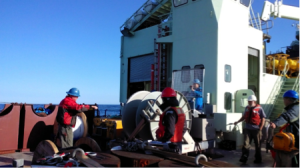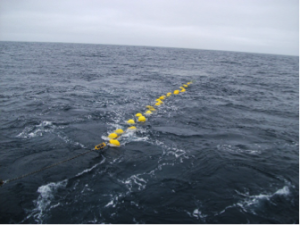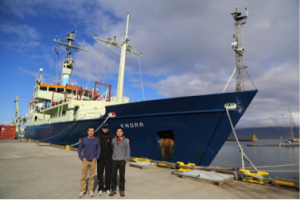by Xiaopei Lin and Dexing Wu
“Pay out the wire slowly and keep it tense in the water, okay?”
“Got it!”
“Okay, go ahead.”
It was another foggy and calm morning in the Subpolar Atlantic onboard the R/V Knorr. John Kemp, the mooring group leader, was teaching Chun Zhou, a physical oceanography PhD student from China, how to drive the winch to lay the mooring wire rope into the water. Almost two months have passed since the end of that cruise. However, some people may still remember Dalei Song, Xiaoman Yang, and Chun Zhou, the three Chinese guys on board who were there representing the Ocean University of China (OUC) and making the university’s first move in cooperation with partners as one of the members of OSNAP.
OSNAP is a US-led international collaborative project designed to provide a continuous record of the full-water column, trans-basin fluxes of heat, mass and freshwater in the subpolar North Atlantic using a network composed of moorings, ship-based hydrographic sections, RAFOS floats and gliders. As planned by the principal investigators, the objective for Cruise #Kn221-03 was to deploy moorings, carry out several high-resolution CTD sections, and deploy dozens of RAFOS floats. Taking into consideration the OUC participants’ experience with mooring operation, Dr. Bob Pickart, the chief scientist of this cruise, assigned them to John, who led a small group comprised of the best hands in mooring operation.
The field operations group was mainly composed of technicians from WHOI’s Mooring Operations, Engineering, and Field Support Group and Sub-Surface Mooring Operations Group, which provide mooring services including mooring design, preparation, deployment and recovery. All these procedures are complicated and worth a detailed introduction, but here I will focus on the deployment and present how one regular day passes by on the Knorr.
After lunch, the technicians picked out all wire ropes designed for the mooring to be deployed the next day. Under the help of a tension cart, they guided the wire ropes onto the winch one by one and linked them together with pear rings and shackles. While the wire ropes were being prepared, other technicians double checked the status of the stand-by instruments to make sure they were good. Occasionally they need to be lowered down into the water with the CTD rosette to be checked for their working status in the water and to provide reference for data correction after recovery. Another important procedure to go through before deployment is the bottom survey. The exact depth is required to adjust the length of wire ropes to keep the instruments at target depths. As the Knorr steamed back towards the target site and the bottom survey went on through the night, the deck became alive with technicians setting the sphere, glass balls, and the anchor.
After a quick breakfast, the deployment started. The temperature chain on top of the mooring was the first to go overboard, followed by the sphere which was lowered down carefully onto the water with crane. While this was going on, the Knorr steamed slowly towards the target site to keep the mooring lying straight on the water behind it. Just as Chun had the day before, the winch driver then paid out the wire ropes steadily and kept the wire rope somewhat tense, preventing wire ropes from loosening and twisting. As the wire ropes were laid into the water, technicians added instruments to the links between two wire ropes. After all the other parts of the mooring aside from the anchor were in a straight line on the water, the tricky task was to then drop the anchor to the bottom of the target site thousands of meters below the surface. When the anchor was dropped, the upper parts of the mooring, especially the sphere, would first drift towards the Knorr and then go down with the anchor. Due to the strong resistance of the sphere when it was dragged towards the anchor-dropping site, the anchor would fall back somewhat like a swing. For this reason, when the Knorr arrived at the target site, she would go further for a distance about 15% of the mooring length to let the anchor fall as close to the target site as possible.
After the mooring equipment was deployed it was time to let go of the anchor and give it some time to touch the bottom.
Not surprisingly, there would be a little distance between the target site and the location where the mooring was pinned to. It is for this reason that we need to do acoustic surveys to determine the exact location of the mooring. On the cruise, technicians calculated the slant range by receiving acoustic response from the transducer mounted on the mooring from usually three different locations around the target site, and determined that the mooring was standing at the intersection of the circles. When all this was done, the mooring had already started recording data so it was time to enjoy the lunch.
For someone who is watching mooring deployment for the first time, he or she may think that there is a lot of stuff going on, but that it doesn’t seem to be very difficult. However, aside from the rich experience and perfect cooperation between the technicians that make the whole operation seem pretty easy, each and every step of the mooring process mentioned above is worth a whole chapter to be described in detail.
That’s how the three OUC guys spent their 29 days onboard with the other mooring technicians during the Cruise #Kn221-03. OUC leaders value this project and the cooperation with the other OSNAP partners very much. After the cruise, they assembled a wide range of principal investigators in OUC and held a forum to discuss how to deepen the cooperation with the other members. In the coming year, when the 2-year moorings are standing their watch of the overturning in subpolar north Atlantic, OUC will pilot gliders with WHOI and the Scottish Associate of Marine Science through the eastern subpolar Atlantic, making up the fence for the overturning circulation.



